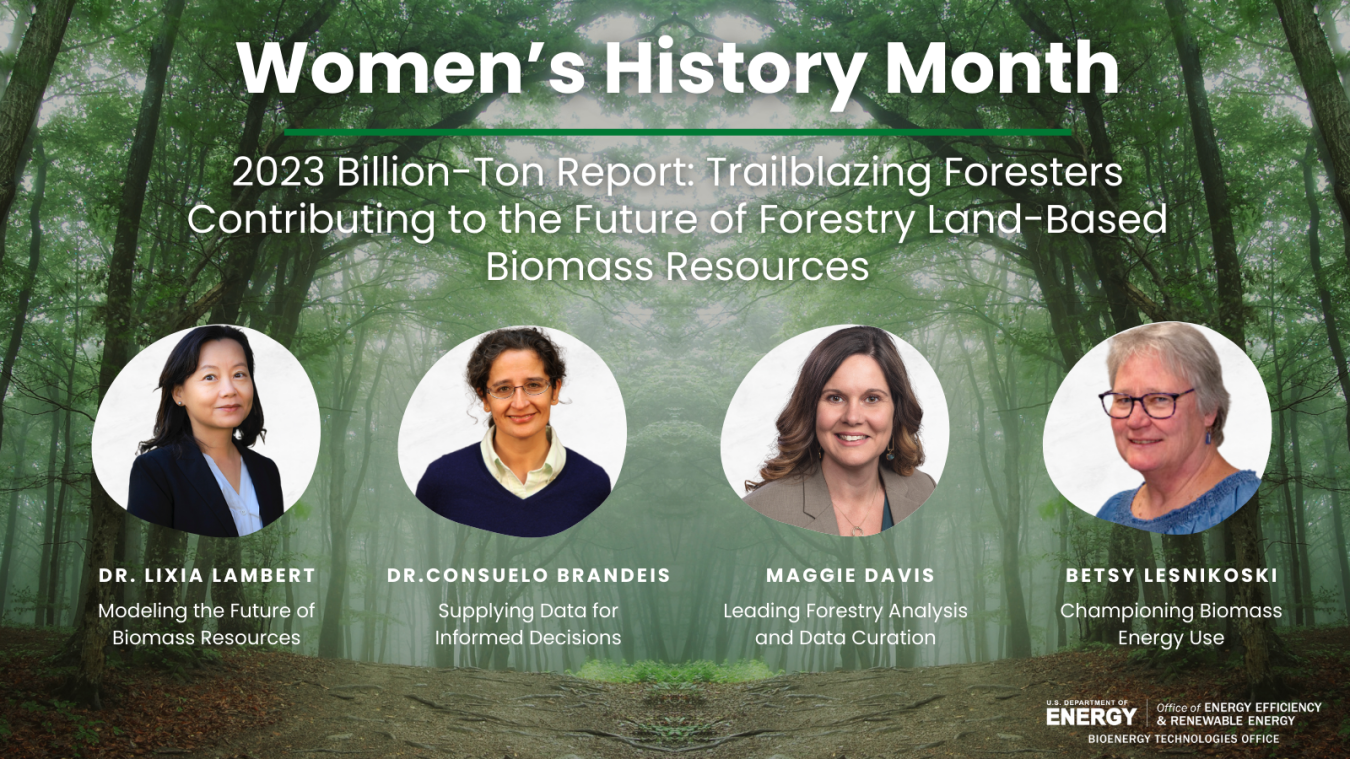On March 15, 2024, the U.S. Department of Energy (DOE) released the 2023 Billion-Ton Report (BT23), which shows that the United States could sustainably triple its production of biomass to more than 1 billion tons per year.
March 27, 2024
On March 15, 2024, the U.S. Department of Energy (DOE) released the 2023 Billion-Ton Report (BT23), which shows that the United States could sustainably triple its production of biomass to more than 1 billion tons per year. The report—the fourth in a series of assessments of potential biomass resources in the U.S. since 2005—finds that 1 billion tons of biomass could satisfy over 100% of the projected demand for airplane fuel in the country, allowing the U.S. to fully decarbonize the aviation industry with sustainable aviation fuel.
The BT23 Report analyzes the biomass production capacity of approximately sixty resources, several of which have never before been analyzed for a DOE Billion-Ton assessment. These resources include trees and brush harvested from forests to prevent wildfires, winter oilseed crops, macroalgae such as seaweed cultivated in ocean farms, and carbon dioxide from industrial plants. The report finds that the wide dispersion and variety of these resources can ensure that the benefits of expanded biomass production extend to both rural and urban areas.
Four trailblazing scientists provided input to the BT23 forestry analysis, and their contributions are shaping the sustainable future of forestry land-based biomass resources. In observance of Women’s History Month, DOE’s Bioenergy Technologies Office is highlighting contributions from Dr. Lixia Lambert, Dr. Consuelo Brandeis, Maggie Davis, and Betsy Lesnikoski to the development of the BT23 Report. These scientists are raising awareness how forestry plays a critical role in meeting the nation’s clean energy goals, an important skillset needed to continue preparing the next generation workforce, and how women are pivotal to the success of expanding biomass production.
Dr. Lixia Lambert—Modeling the Future of Biomass Resources
As an Assistant Professor in agricultural economics at Oklahoma State University, Dr. Lambert spearheaded the modeling efforts crucial to the BT23 Report's analysis of biomass resources in the contiguous United States. Her expertise in computational modeling has enabled a nuanced understanding of biomass availability, distribution, and potential impacts on ecosystems. Lambert's input provides invaluable insights into the sustainable management of biomass resources.
Dr. Consuelo Brandeis—Supplying Data for Informed Decisions
Dr. Consuelo Brandeis, a research scientist specializing in timber product output data at the U.S. Department of Agriculture, Forest Service (USDA-FS), has been instrumental in supplying essential data for waste resource analyses incorporated into the BT23 Report. Brandeis's meticulous research provided a comprehensive view of timber utilization and waste streams, informing strategies for optimizing resource efficiency and minimizing environmental impact. Her work underscores the importance of data-driven decision-making in forestry management, paving the way for more sustainable practices across the industry.
Maggie Davis—Leading Forestry Analysis and Data Curation
At the Oak Ridge National Laboratory, Maggie Davis, a research scientist in sustainable management of forested and agricultural lands, has played a multifaceted role in shaping the BT23 Report. Overseeing the combination of three model outputs to the forestry analysis and leading the forest waste analysis with the USDA-FS, Davis, as BT23 chapter lead, brings her expertise to bear in synthesizing complex data into actionable insights. Moreover, her contributions extend to data curation under the bioenergy Knowledge Discovery Framework data portal (bioenergyKDF), facilitating researchers’ and stakeholders’ access to vital information. Davis's dedication to transparency empowers collaboration and innovation in the pursuit of sustainable bioenergy solutions, guiding policymakers and stakeholders toward evidence-based decisions.
Betsy Lesnikoski—Championing Biomass Energy Use
Betsy Lesnikoski's expertise as Burlington Electric’s Chief Forester in Vermont enriched the BT23 Report with her insights into the current utilization of biomass for energy production. Through her contributions, Lesnikoski shed light on practical applications of biomass resources, drawing from her firsthand experience in the field. Her expertise in understanding the challenges and opportunities of biomass energy use at the local level informs broader strategies for scaling up renewable energy adoption. Lesnikoski's advocacy for sustainable forestry practices serves as a beacon for communities seeking to embrace clean, renewable sources of power.
The BT23 report stands as a testament to the collective expertise and dedication of women in the forestry profession like Dr. Lixia Lambert, Dr. Consuelo Brandeis, Maggie Davis, and Betsy Lesnikoski. Their contributions not only deepen our understanding of biomass resources but also inspire us to chart a course toward a more sustainable future. As we navigate the complexities of forestry analysis, let us continue to heed the insights of these women, forging a path toward resilience, innovation, and environmental stewardship.
Each woman is shaping the landscape of biomass analysis and sustainable resource management. Their extraordinary efforts and expertise in forestry science serve as an example to the indelible impact of women in driving progress and innovation across the bioenergy and forestry industry. Watch this BT23 forestry case study video to discover more about these dynamic women foresters and their contributions to the BT23 Report.
To learn more about DOE’s efforts to build a strong, low-carbon bioeconomy, visit the BT23 Report webpage. Visit bioenergyKDF, the bioenergy data portal that supports the data-driven bioeconomy, to further explore BT23 and bioenergy data-driven analyses, interactive maps, and graphics.

